
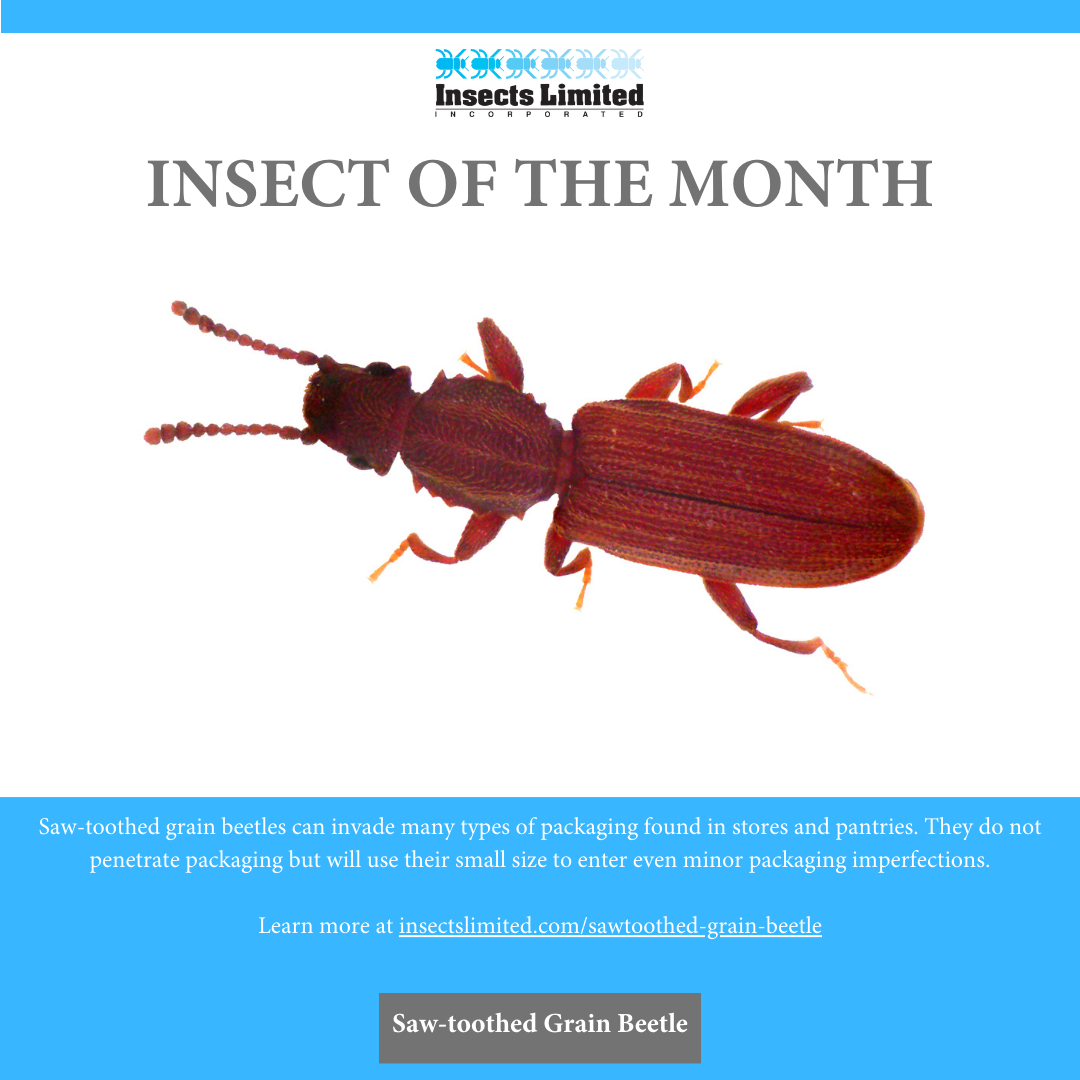
Insect of the Month: Saw-toothed Grain Beetle (Oryzaephilus surinamensis)
Female grain beetles will deposit 50-300 eggs in food during a 6-month -3 year life span. Eggs hatch in 5-12 days, and the larvae can mature within 35 days or if 50 days depending on temperature. These insects are very good at crawling on any surface including glass, and steel. Despite their size, they can roam some distance from infested food products.
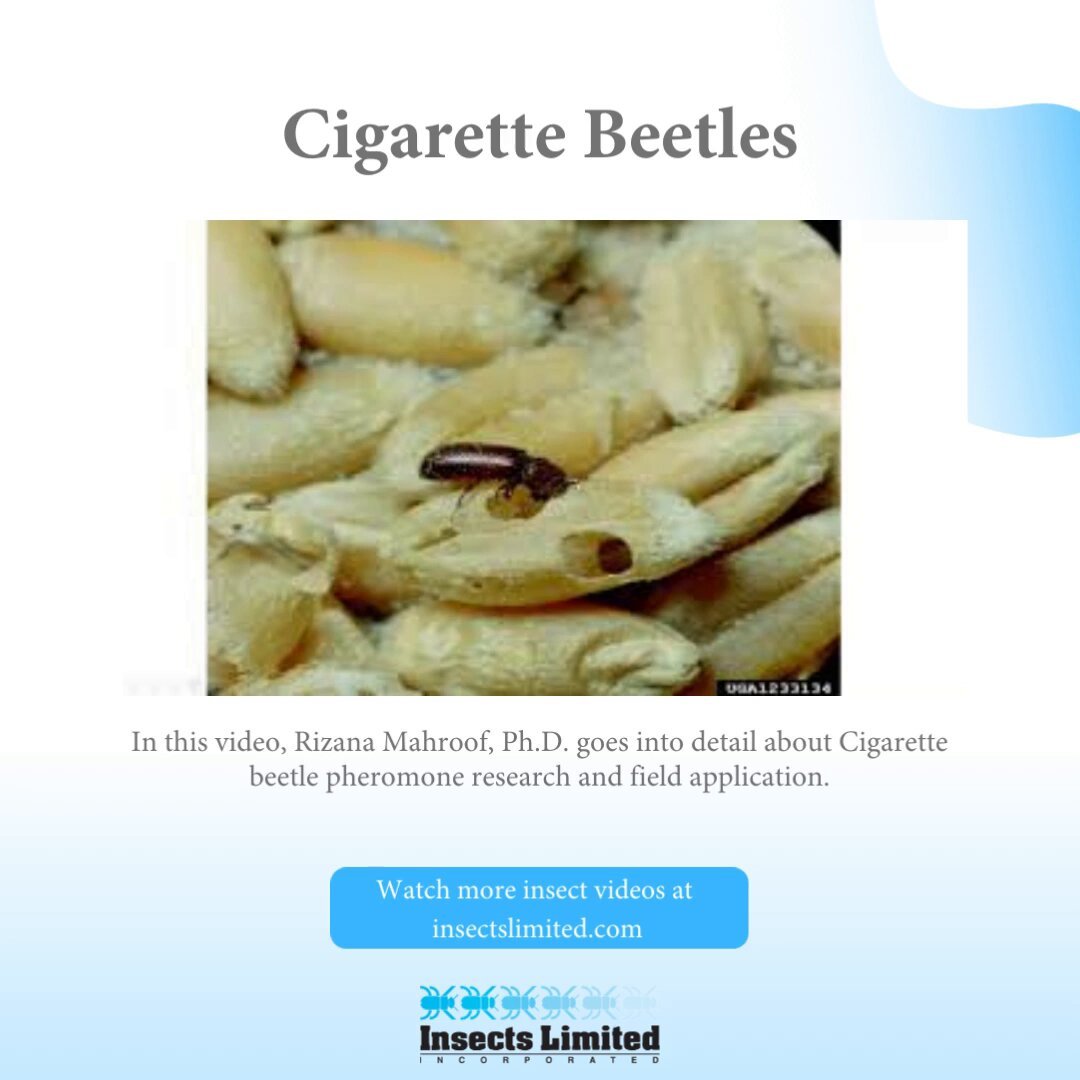
Watch: Cigarette Beetle Pheromone Research and Field Application
Following the theme this month, in this video, Rizana Mahroof, Ph.D. goes into detail about Cigarette beetle pheromone research and field application.

Product of the Month - All Beetle Trap Kit with RTU Gel Cartridge
Working closely with the pest control industry, Insects Limited recognized pest control operators and residential customers alike needed a Ready-To-Use (RTU) device to monitor for beetles that could fit in areas suspected of insect infestation without taking much space.

Insect of the Month: Cigarette Beetle (Lasioderma serricorne)
Packages and food products infested with cigarette beetles usually have shot holes where adults have emerged from pupation. Adults and larvae cause damage. Adults are excellent fliers and are attracted to lights. These beetles are commonly found in tobacco and other processed foods such as spices, flour, meal, and dog food, but can also attack horn, wool, hair, hide, pharmaceuticals and even book bindings. It is a common household pest.

Watch: Hide Beetle Biology, Habits and Life Cycle
Following the theme this month, the Hide Beetle, Dermestes maculatus' biology, habits and life cycle are covered in this video.

A Reflection on the 14th Stored Product Protection Conference
It was worth it.
Sweating the details, investing the capital, fretting for the first two months after the announcement and wondering if anyone is going to show up, organizing the tours, acquiring the sponsorships, working with the speakers, creating the content, designing the posters, sacrificing other areas of the business, assembling welcome packets, multiple site visits, arguments/heated conversations, and (oh yeah) preparing a presentation as well as moderating.
It was all worth it.

Product of the Month: All Beetle Hide Beetle Kit (IL-2000)
The All Beetle Hide Beetle Kit combines the power of Insects Limited’s signature pheromone lures for Hide Beetle, Dermestes maculatus, with the innovation of the three-part All Beetle Trap™
All Beetle Hide Beetle kits feature Insect Limited’s signature pheromone lures that use a blend of 8 different pheromones mixed into a food attractant, to draw-in hide beetles over a 3-month period.

Are we inviting clothes moths into our living and working spaces?
Clothes moths are the number one pest in the world that consume and damage our clothing and rugs. Unknown to many, adult clothes moths do not eat, instead the larval stage of this damaging pest is the only one doing the damage.

Insect of the Month: Hide Beetle (Dermestes maculatus)
The hide beetle is often found on dried meat products such as pet food and is most often discovered as a hairy larva in the bottom of pet food bags. These larvae can burrow into paper, cardboard, Styrofoam insulation and wood, leaving a round hole approximately 6mm (0.25”) in diameter.
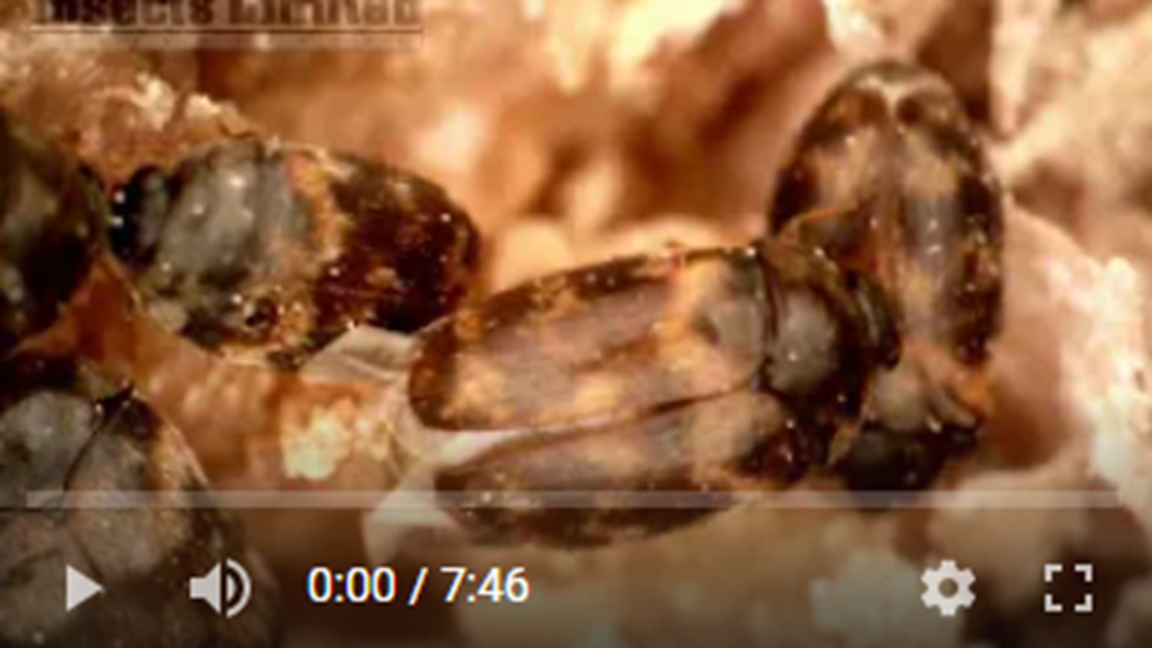
Watch: Complete Lifecycle of the Warehouse Beetle
Following the theme this month in the video featured below, entomologist Patrick Kelley discusses the detailed life cycle of the warehouse beetle from egg to adult.

Product of the Month - PTL Multi-Species Kit (IL-408-10)
PTL represents the Plodia/Trogoderma/Lasioderma insects. The PTL Multi-Species Kit (IL-408-10) features the Insect Limited’s signature pheromone Bullet Lures™ that attract the most common pests of dried goods: Indian Meal Moth (Plodia interpunctella), Mediterranean Flour Moths (Ephestia kuehniella), Almond Moth (Ephestia cautella), Tobacco Moths (Ephestia elutella) and other food moth species; Trogoderma food beetles such as the Warehouse beetle, (Trogoderma variabile), Khapra beetle, (Trogoderma granarium) as well as (Trogoderma glabrum) and (Trogoderma inclusum); and also the Cigarette beetle (Lasioderma serricorne) species with a controlled release of pheromone over 3 months.
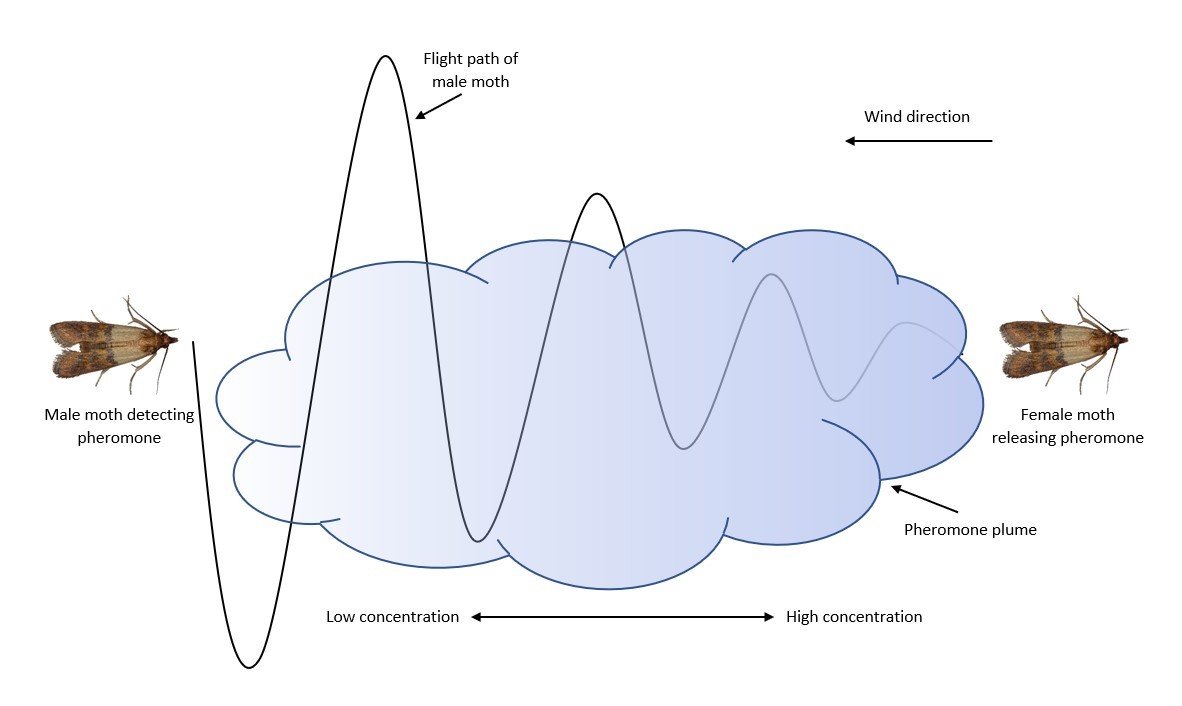
What Are Pheromones?
Pheromones are chemicals that are released by insects that stimulate a behavioral change to other insects of the same species.
This form of chemical communication is used by insects to direct social behavior - including mate attraction, gathering together, egg-laying, foraging for food, trail following, and colony defense

Insect of the Month: Warehouse Beetle (Trogoderma Variable)
Warehouse beetles occur in all life stages in warm buildings, throughout the year with two or three generations occurring each year. Females mate within one day of emerging from the pupa. Five to sixty eggs are deposited near a food site. Larvae will molt 5 or 6 times before pupating.

Why Pest Identification Matters
If part of your job involves pest management, trying to solve pest outbreaks can often become a roller coaster ride with all its ups and downs.
Initially, insect pests make themselves known to us by spilling into our living spaces and workspaces.
First reactions can include annoyance, disgust and in some cases shock when pest damage is revealed.
There is often a knee-jerk reaction is to apply a pesticide to the area to kill everything on six legs.

Watch: Complete Lifecycle of the Fruit Fly
Fruit flies progress from egg, through several larval instars, to pupa and then to adult in as little as 10 days. Males initiate courtship rituals after picking up short-range pheromones from females. Adult fruit flies can live up to 40 days.

Product of the Month - GreenWay Fruit Fly Kit (12 bottles) (IL-1520)
The GreenWay Fruit Fly Kit (IL-1520-12) features the Insect Limited’s custom attractant for common fruit flies. It has been designed to capture red-eyed fruit flies but will also capture dark-eyed fruit flies.

Insect of the Month: Fruit Fly (Drosophila melanogaster)
Fruit flies feed primarily on moist, decaying, organic food items including fruits, vegetables and other fermenting liquids.
Fruit fly infestations can be identified by numerous adult insects flying around a food source or from the maggots infesting decaying food. In heavy fruit fly infestations, pupae can be found some distance from the food source when the larvae migrate away to find a dry, dark, and safe place to pupate.
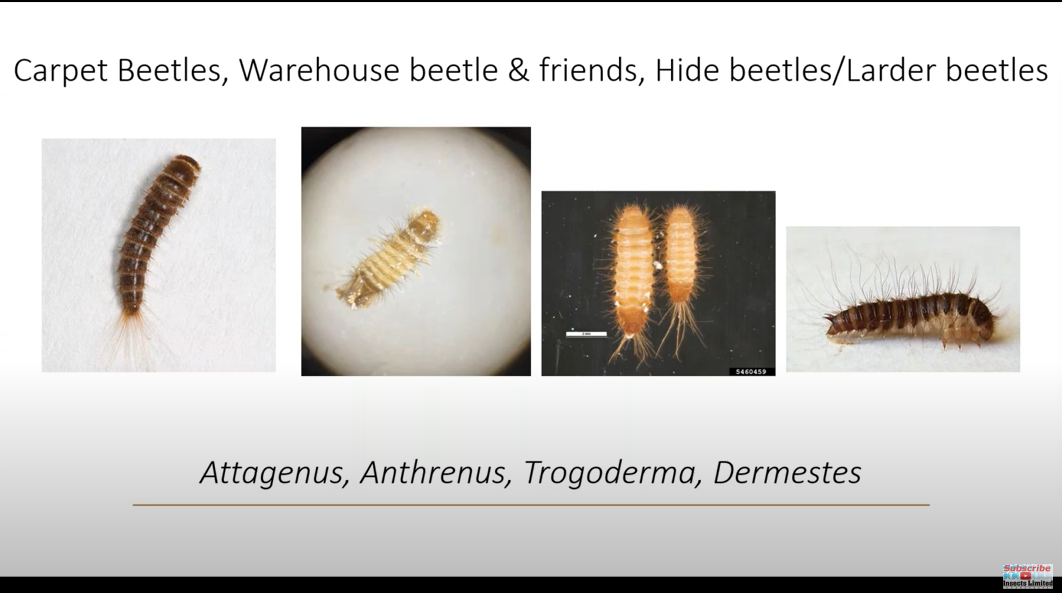
Watch: Carpet Beetles and Other Dermestids - How, why, and what to do about them
James Feston, BCE discusses carpet beetles and other dermestids: How, why and what to do about them.

Product of the Month: All Beetle AA Carpet Beetle Kit (IL-2110)
This All Beetle AA Carpet Beetle Kit includes 10 or 100 (select your quantity) complete All Beetle traps, 10 or 100 dermestid attractant lures, 10 pheromone Bullet Lures™ for Varied Carpet Beetles (Anthrenus verbasci), and Black Carpet Beetle, (Attagenus unicolor), as well as a glue board specifically designed to fit the All Beetle trap removable tray.
